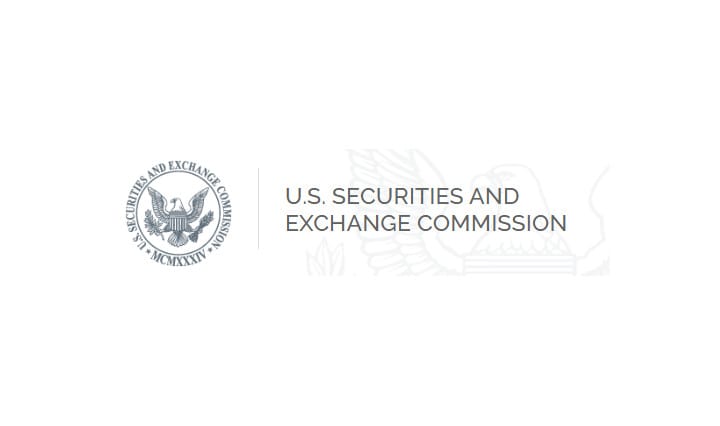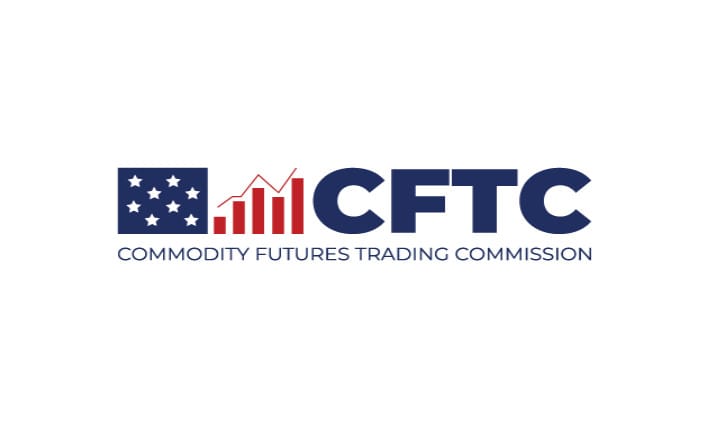"I am pleased to support the adoption because it will improve the quality of the information we receive, particularly from large hedge fund advisers. This will help the SEC & FSOC to better assess systemic risk and protect investors."

Statement on Final Joint Amendments to Form PF
Today, the Commission voted to adopt amendments to Form PF, an important reporting tool whereby the Commission and the Financial Stability Oversight Council (FSOC) receive reporting from private fund advisers. I am pleased to support the adoption because it will improve the quality of the information we receive, particularly from large hedge fund advisers. This will help the SEC and FSOC to better assess systemic risk and protect investors.
Lest we forget, as a result of the 2008 financial crisis, eight million Americans lost their jobs, millions of Americans lost their homes, and small businesses across the country folded. Systemic risk from the banking and non-bank sectors alike spilled out into the broader economy.
In response to the 2008 crisis, Congress mandated that the SEC and the Commodity Futures Trading Commission (CFTC) adopt rules to establish reporting requirements for private funds. This reporting is to be “as necessary and appropriate in the public interest and for the protection of investors, or for the assessment of systemic risk.” Thus, the two commissions jointly adopted Form PF in 2011.
I had the privilege to serve as Chair of the CFTC at the time. As I said when Form PF first was adopted, “With this final rule, regulators will gain transparency into an important sector of the financial marketplace to better assess risk to the overall system.”[1]
Private funds have evolved significantly in the 13 years since Form PF first was adopted. Further, private funds today are ever more interconnected with the broader capital markets.
Private funds nearly have tripled in size in the last decade to approximately $26 trillionin gross assets.[2] This compares with the U.S. commercial banking industry of approximately $23 trillion.[3] This makes visibility into these funds critical.
Since Form PF first was adopted, the Commissions and FSOC have identified gaps in the information we receive. Today’s adoption enhances the Commissions’ and FSOC’s understanding of the private fund industry as well the potential systemic risk posed by the industry and its individual participants. In addition, the adoption also furthers investor protection efforts.
Today’s final rules concern the Commissions’ joint sections on Form PF. These amendments will, among other things, expand the reporting requirements for large hedge fund advisers on their large hedge funds in three important ways.[4]
First, the final rules will expand reporting requirements about a large hedge fund’s investment exposures. Reporting on fund exposures to different types of assets has been critical to help monitor the risks that large hedge funds may present to the markets. Expanding such reporting from large hedge fund advisers will enhance investor protection efforts and the assessment of systemic risk.
Second, the final rules will expand reporting requirements about a large hedge fund’s open positions and certain large positions. These requirements will provide insight into the extent of a fund’s portfolio concentration and large exposures to any specific assets. Such concentration or exposure may increase the risk of amplified losses for investors. Gathering additional data on concentration and exposure will help to protect investors and assess systemic risk.
Third, the final rules will expand reporting requirements on large hedge funds’ borrowing and financing arrangements with counterparties, including central clearing counterparties. Gathering such information will help the Commissions and FSOC better to observe how hedge funds interconnect with the broader financial services industry.
In finalizing this adoption, we benefitted from public feedback on our proposed rules and made a number of appropriate changes.
Today’s adoption is the third step the Commission has taken in the last two years to update disclosure of this important sector of the capital markets.
First, in May 2023, we adopted requirements for certain advisers to hedge funds and private equity funds to provide current reporting of key events. Those rules also enhance reporting requirements for large private equity fund advisers. The first phase of the implementation went into place in December 2023.
Second, in July 2023, we finalized amendments to Form PF for large liquidity fund advisers to align their reporting requirements with those of money market funds.
Third is today’s adoption. I believe that these final rules will bring greater visibility for regulators into an important part of our capital markets. That will help protect investors and maintain fair, orderly, and efficient markets.
In addition to the adoption of these final rules, the Commission today also entered into a memorandum of understanding with the CFTC to facilitate data sharing between our agencies regarding information submitted to us on Form PF. I believe such data sharing will help our Commissions coordinate in overseeing this important area of the capital markets.
I’d like to thank members of the SEC staff for their work on these final rules, including:
- William Birdthistle, Sarah ten Siethoff, Melissa Harke, Adele Murray, Tom Strumpf, Jill Pritzker, Neema Nassiri, Timothy Husson, David Stevens, Jon Hertzke, Michelle Beck, Holly Miller, Timothy Dulaney, Kevin Treharne, Trevor Tatum, Steve Flantsbaum, and Kolby Quass in the Division of Investment Management;
- Jessica Wachter, Charles Woodworth, Ross Askanazi, Caroline Schulte, Dan Hiltgen, Michael Davis, and Rachel Li in the Division of Economic and Risk Analysis;
- Meridith Mitchell, Natalie Shioji, Monica Lilly, and Alice Wang in the Office of the General Counsel;
- Christopher Mulligan and Daniel Faigus in the Division of Examinations; and
- Nikolay Vydashenko in the Division of Enforcement.
[1] SeeCommodity Futures Trading Commission, “CFTC and SEC Approve Confidential Private Fund Risk Reporting” (Oct. 31, 2011),available athttps://www.cftc.gov/PressRoom/PressReleases/6132-11.
[2] See Form ADV data (inclusive of assets attributable to securitized asset funds).
[3] SeeBoard of Governors of the Federal Reserve System, “Assets and Liabilities of Commercial Banks in the United States” (Feb. 2, 2024),available athttps://www.federalreserve.gov/releases/h8/current/default.htm. Total assets of approximately $23.3 trillion as of Jan. 24, 2024 (Table 2, Line 33).
[4] As detailed in the Adopting Release, the amendments will apply to hedge funds with at least $500 million in net asset value, also known as qualifying hedge funds.
What Gary is happy about:
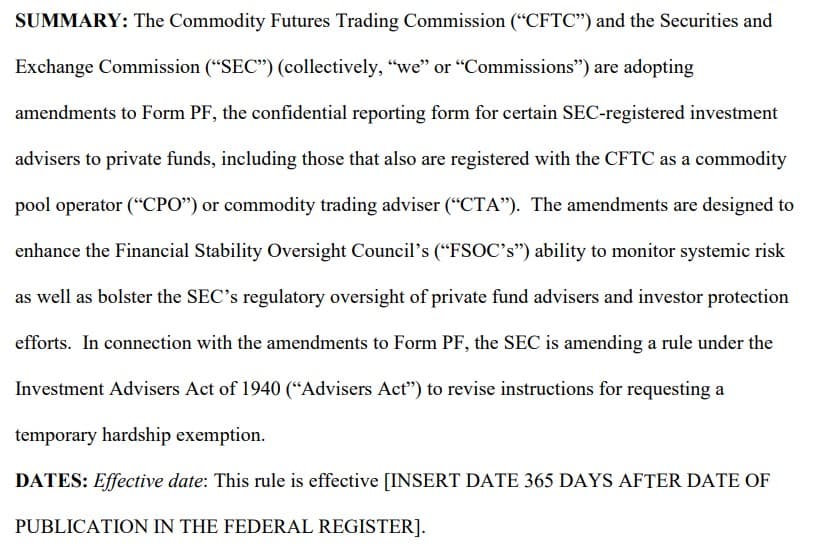
Wut Mean?
Among other things, the amendments to Form PF will enhance how large hedge fund advisers report investment exposures, borrowing and counterparty exposure, market factor effects, currency exposure, turnover, country and industry exposure, central clearing counterparty reporting, risk metrics, investment performance by strategy, portfolio liquidity, and financing and investor liquidity to provide better insight into the operations and strategies of these funds and their advisers and improve data quality and comparability.
Further, the amendments will require additional basic information about advisers and the private funds they advise, including identifying information, assets under management, withdrawal and redemption rights, gross asset value and net asset value, inflows and outflows, base currency, borrowings and types of creditors, fair value hierarchy, beneficial ownership, and fund performance to provide greater insight into private funds’ operations and strategies, to assist in identifying trends, including those that could create systemic risk, to improve data quality and comparability, and to reduce reporting errors.
The amendments will also require more detailed information about the investment strategies, counterparty exposures, and trading and clearing mechanisms employed by hedge funds, while also removing duplicative questions, to provide greater insight into hedge funds’ operations and strategies, to assist in identifying trends, and to improve data quality and comparability.
Fact Sheet
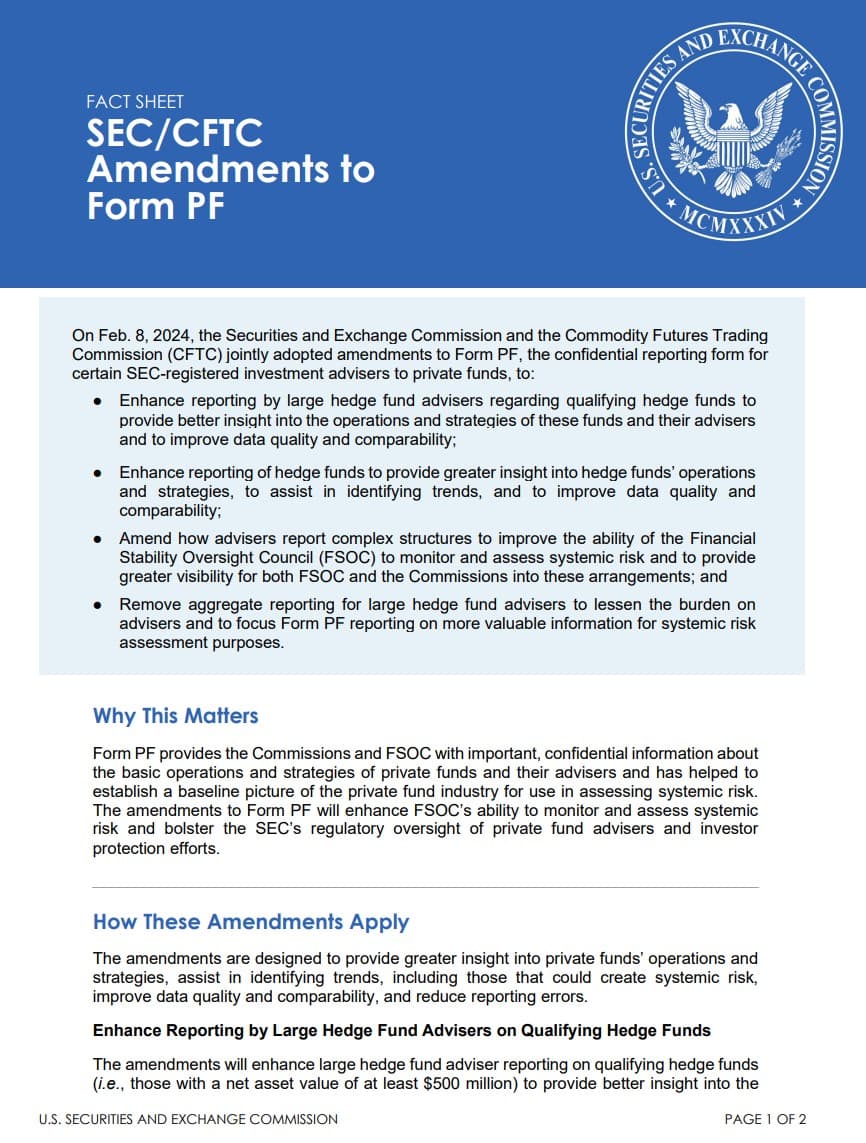
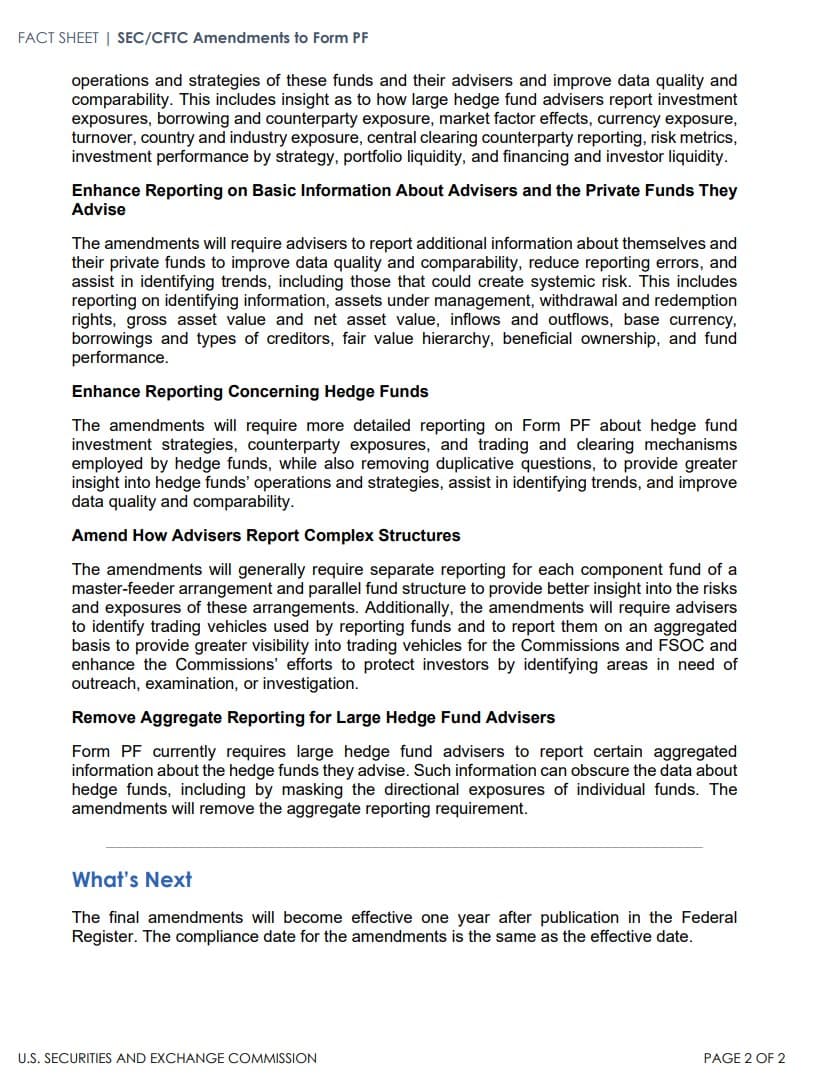

TLDRS
- Gary Gensler on amendments to Form PF: "I am pleased to support the adoption because it will improve the quality of the information we receive, particularly from large hedge fund advisers. This will help the SEC & FSOC to better assess systemic risk and protect investors."
- The amendments to Form PF will enhance reporting by large hedge fund advisers on various aspects such as investment exposures, borrowing, counterparty exposure, risk metrics, and investment performance to improve insight into fund operations and strategies, and enhance data quality and comparability.
- Additional information will be required about advisers and the private funds they manage, including details on assets under management, withdrawal rights, gross and net asset values, inflows and outflows, and fund performance, aimed at providing a deeper understanding of private funds’ operations, assisting in trend identification, and reducing reporting errors.
- The changes will also demand more detailed reporting on investment strategies, counterparty exposures, and trading and clearing mechanisms, while eliminating redundant questions to offer a clearer view of hedge funds’ operations and strategies, help in trend analysis, and enhance data quality and comparability.
- Affective 1 year after being published in the Federal Register.

